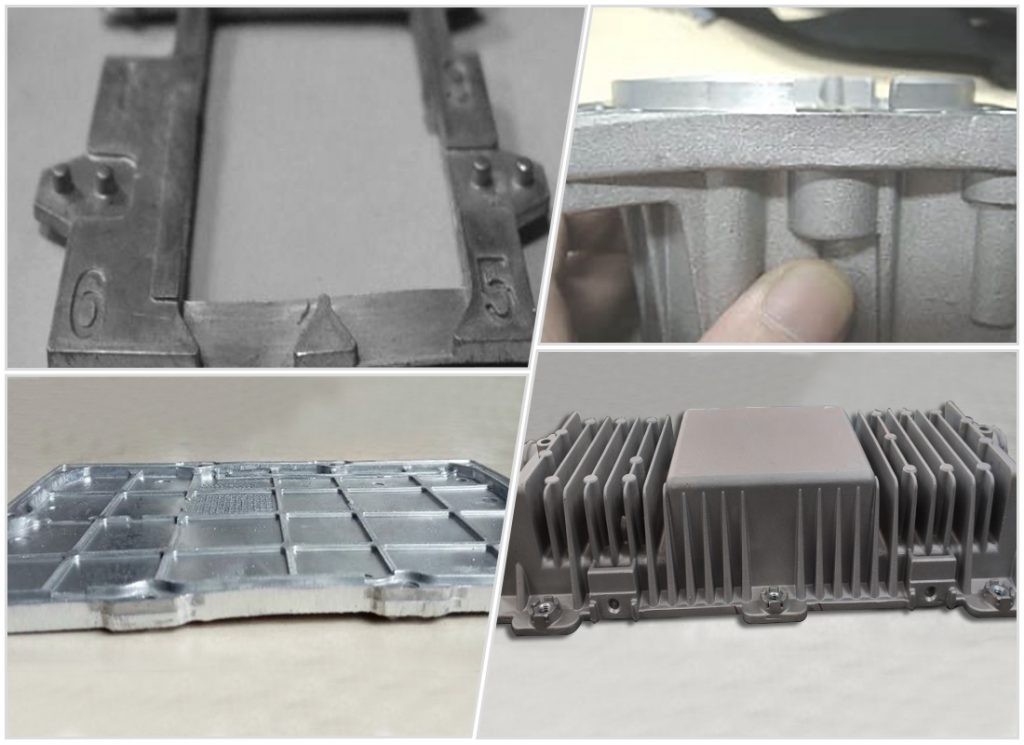Causes analysis and improvement methods of deformation in die casting parts

Posted on : March 23, 2022 By GREFEE

To learn more problems and preventions of die casting, click to check it out.
What is deformation of die casting products?
The casting deformation is caused by the geometry inconsistent with the drawing, which is featured by warpage, overall deformation or local deformation.
Causes:
- improper casting structure design causes uneven shrinkage
- Mold opened too early and be formed without sufficient chilled and the rigidity is insufficient
- Small product angle causes too large pulling force when releasing the mold.
- Improper operation when taking out the casting
- Improper ejector rod position, imporoper stacking of castings due to inclined ejection.
- improper removing the gate, especially the gate to be designed with curve structure
- Local damages to mold cavity, serve strain causes local deformation
- Poor mold release agent and deformed due to mold sticking problem.
- Uneven mold release agent painting causes deformation due to inconsistent mold releasing.
- Big temp difference in different areas of cavity causes inconsistent mold releasing or local mold sticking problems.
- Caused by post-treatment like shot blasting
- Improper transporting and packaging
How to improve deformation problems (measure it is mold opening deformation/ejection deformation/shrinkage deformation)
1. The casting is obviously deformed after placing for a period of time out of the mold – adjusts mold structure to make wall thickness uniform.
2. Sinks on thick areas of casting, material cake might be squeezed together – increases pressure maintaining time and casting rigidity
3. There is brightening marks and strains on side with too small die casting angle – increases the die casting angle if it is possible.
4. Bumping marks on surface – cautiously taking and placing the casting. Takes parts from cavity should avoid clamping the casing body.
5. Manual ejection after mold opening to see whether another end is ejected first or not – increases or reduces the local ejector rod accordingly to ensure the ejection balance.
6.stacking the castings with specific packages and separated by paper board.
7. Uses drop gate for castings that are easily to be deformed, have to be aware of the direction. The best way is to use blanking die.
8. Damages to mold surface, the according areas has burrs due to strains – repairs the mold.
9. Aluminum sticks to casting corners or die core heavily – change mold release agent.
10. Mold sticking, there is abnormal sound in ejection – uniform painting
11. Local mold sticking, uses mold thermometer to check the mold cavity temp- adds local cooling points or uses forced cooling by increasing coating amount to ensure the mold cavity temp is balanced overall.
12. Evaluates by the dimension inspection before and after the shot blasting – uses proper shot blasting technology, like speed, time, etc. uses steady hanging methods. Special fixtures needed if necessary.
13. The product is squeezed – uses anti-high impact outer packaging and separates parts piece by piece to protect.
Key inspection areas to die casting parts
Die casting deformation is likely to happen in products which are thin walled and long-strip shaped or extended ear shape features and other areas.
How does strain affect products?
For products with strains, they are likely to have improper sizes which affect the assemble and sealing of products.
How to evaluate whether a deformed die casting product is qualified or not?
1. The testing to deformed die casting products is mainly by horizontal table or feeler gauge.
2. Cannot scale out the deformation level. Generally, 0.1mm for under 400T die casting machines and 0.3mm or lower for over 400T die casting machines.
3. Pay attention to situations like deformation, round holes to elliptical holes due to mold pulling
4. Confirmation is needed in the inspection process, normally there is product sticking, strains, and brightening. Needs to check whether there’s deformation or not, affecting the flatness.Be careful of product local deformation
5. There might have shaping in post-treatment. The flatness differences will seriously affect the yield of shaping and efficiency.
6. Strictly controlling process if there are too many issues.
Improving the deformation in die casting
There are many reasons for deformation in die casting. Generally, it results from poor rigidity of product design, imbalanced ejection, or insufficient cooling. To deal with these issues effectively, it needs to maintain a uniform wall thickness in the design and ensure sufficient strength. After that, carries out simulation for ejection in assemble stage and increases the mold cooling, maintaining the mold temp. By doing so, the die casting production can be carried out effectively.
How to avoid deformation in die casting? You can ask the die casting expert – GREFEE has 20 years of die casting experience. Contact us for a cost-effective and high-quality die casting service.
MORE BOLG
Insert mold in injection mold service
What are advantages and disadvantages of Zinc alloy and Aluminum alloy?
Inspection standards for injection molded partappearance
How to judge the quality of your plastic products?
Inspection standards for CNC machining
To ensure that your products are 100% qualified
Categories

Try GREFEE now,for free
We keep your uploaded files confidential and secure.



